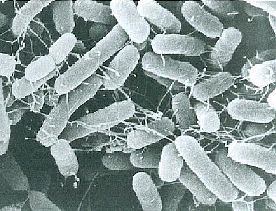Tokyo Food Safety Information Center » Good things to know » The microorganisms which cause food poisoning » Salmonella Enteritidis
Salmonella Enteritidis
Characteristics

From the second half of the 1980s, food poisoning caused by Salmonella Enteritidis (SE) has been prevalent in Europe and North America. Japan also experienced a sharp increase in cased starting from 1989, but since 1999 SE has shown a declining trend in cases.
The most common cause of SE-related food poisoning is eggs and foods made with eggs, and there are believed to be two main pathways which result in the contamination of chicken eggs with SE. The first is eggs already containing SE before laid by infected chickens. The second is SE being transferred from feces of an infected parent to the exterior of an egg and permeating through the shell to the interior.
Accordingly, it is important to remember that eggs may carry SE and take sufficient care when handling eggs, including refrigerating the eggs you purchase and never leaving eggs you have cracked open to sit for any period of time.
Which foods can cause SE infection?
Primarily eggs and foods made using eggs. Secondary contamination can also occur through transfer to other foods from cooking utensils and hands which have come in contact with eggs.
What are the symptoms of SE infection?
The incubation period for SE is normally believed to be 8 to 48 hours; however, cases of illness occurring after and incubation period of 3 to 4 days have been reported. Stomach pain, diarrhea, fever (38-40° C), and vomiting are the primary symptoms of SE infection.
What are the key points to preventing SE infection?
- Only purchase fresh eggs. In addition, always be sure to refrigerate them after purchase and consume them within a short period of time.
- Never leave eggs which have been cracked open to sit for any period of time.
- When cooking eggs, ensure that the heat penetrates all the way to their center (a general guideline is when the both the yolk and white of the egg have become firm).
- Always wash and disinfect utensils, dishes, and hands whenever they come in contact with chicken eggs (preventing secondary contamination).
- If you choose to eat raw or partially cooked eggs, always use eggs specifically sold for eating raw and strive to eat them as quickly as possible after purchase.
- Never give insufficiently cooked eggs to young children and the elderly (high risk groups for SE infection).